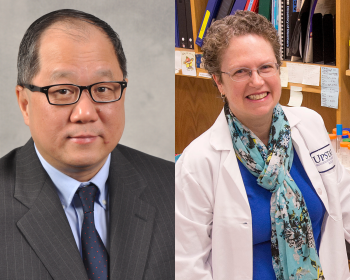Upstate scientists awarded $2 million to unlock secrets of aging: investigating mitochondria-lysosome interaction
Xin Jie Chen, PhD, along with Patricia Kane, PhD was awarded over $2 million dollars from the National Institute on Aging (NIA) over the next five years to study the interaction between different organelles, and their impact on aging. Chen is a distinguished professor, and Kane is a professor and department chair, both in the Department of Biochemistry and Molecular Biology. They hope a better understanding of this newly discovered communication pathway between mitochondria and lysosomes could provide a better understanding of aging-associated degenerative diseases.

Xin Jie Chen, PhD (left), along with Patricia Kane, PhD (right) will be combining their expertise on the biology of mitochondria and the biochemistry of V-ATPase and vacuolar/lysosomal biology to try and better understand the role of the mitochondria-lysosome pathway on aging.
Mitochondria have various roles, including energy production. However, how non-energy-related functions of mitochondria contribute to cell health during aging and disease is unclear.
Lysosomes, which manage cellular processes like pH control and protein degradation, also play a role in aging and degenerative diseases like Parkinson's, ALS, and Alzheimer’s. The researchers want to explore whether problems in both mitochondria and lysosomes could work together to affect important cellular processes that impact cell survival as they age.
This study brings together experts from two scientific fields: Chen specializes in the biology of mitochondria (cellular organelles responsible for energy production), and Kane in the biochemistry of V-ATPase (a protein complex) and vacuolar/lysosomal biology (functions related to cellular waste disposal).
“This grant is a response to a Funding Opportunity Announcement (FOA) from NIA, specifically focused on inter-organellar communication during aging,” says Chen. “This project is expected to generate synergy between the two groups specialized in mitochondria and lysosomes. ”
In this project, the scientists will study a newly identified pathway where mitochondrial issues cause stress in lysosomes, affecting cell survival. They have collected promising initial data from experiments with yeast, human cells, and mice. Their plan involves three main objectives:
- Test if specific mitochondrial stress can damage the vacuoles in yeast (similar to lysosomes in humans) and identify genes that might counteract this stress, potentially extending cell lifespan.
- Confirm the newly discovered mitochondria-to-lysosome stress pathway in human cells grown in a lab.
- Examine if mitochondrial stress damages lysosomes and impacts tissue health in live mice, particularly in tissues that don't regenerate easily. They will also explore how this damage occurs.
"In the long term, if this pathway is validated it would suggest that it can be a good drug target to slow down the progression of aging-associated disorders,” explains Chen. This could provide insights into diseases associated with both mitochondrial and lysosomal problems that often appear together as people age.
“I'm very excited by this project,” says Chen. “ We’re looking forward to some exciting discoveries in the coming five years.”
You can read the full abstract of this project here- https://reporter.nih.gov/project-details/10722759